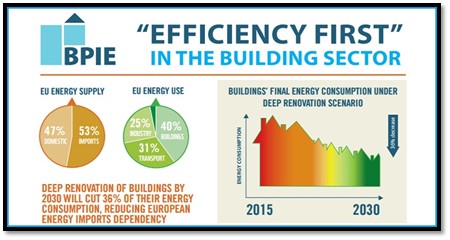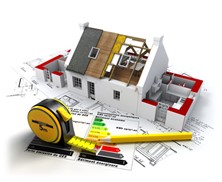AUTORE: Alessio Pucci
TUTORS: Alessandro Zichi e Francesco Gallina
TIROCINIO: Progetto CMR – Massimo Roj Architects
MASTER: Master in “Gestione Energetica di Edifici e Infrastrutture” a.a 2020/21
Il settore edilizio, secondo il World Green Building Council, è responsabile del 36% delle emissioni totali di gas serra, del consumo del 40% di energia per la produzione di calore e di energia elettrica, e del consumo del 50% di materie prime estratte. Realizzare delle abitazioni all’avanguardia e riqualificare quelle esistenti è diventato ormai necessario se si vuole mitigare la quantità di emissioni di gas serra.
La riqualificazione energetica degli edifici esistenti è uno dei temi principali sui quali l’Unione Europea sta lavorando per garantire una significativa riduzione dei consumi di combustibili fossili, e a partire dal 2002 con l’EPBD (Energy Performance Building Directive) sono state emanate una serie di direttive con lo scopo di promuovere l’efficienza energetica rimuovendo la maggior parte delle barriere burocratiche esistenti fino a quel momento.
Le direttive europee hanno contribuito a cambiare non solo la legislazione italiana sul tema di riqualificazione energetica, ma hanno anche portato alla luce le problematiche energetiche che caratterizzano il panorama edilizio e in particolar modo quello residenziale. In Italia il consumo energetico imputabile all’edilizia residenziale si attesta al 33%, ma è necessario considerare che il 50% delle case e dei condomini sono stati costruiti prima degli anni ‘70 e che attualmente non rispettano i requisiti minimi di efficienza energetica imposti dall’UE. Con l’entrata in vigore del Decreto-legge “Rilancio” del 19 maggio 2020, è stata introdotta l’agevolazione denominata Superbonus 110%, ossia la misura di incentivazione fiscale che eleva al 110% l’aliquota di detrazione delle spese sostenute nell’ambito degli interventi di riqualificazione energetica, sismica, di installazione di impianti fotovoltaici e di infrastrutture per la ricarica di veicoli elettrici eseguiti sulle abitazioni. Lo scopo principale del decreto “Rilancio” è favorire l’ammodernamento delle abitazioni rendendo gli interventi edilizi economicamente accessibili a tutti. Gli interventi ascrivibili al Superbonus 110% si suddividono in interventi trainanti e trainati e riguardano l’isolamento delle pareti esterne, la sostituzione dei serramenti, la sostituzione o nuova installazione di impianti di climatizzazione invernale centralizzati o autonomi, installazione di impianti fotovoltaici e colonnine di ricarica di veicoli elettrici.
Durante la mia esperienza di tirocinio maturata presso “Progetto CMR” la fase preliminare di scelta delle misure di riqualificazione energetica è stata focalizzata maggiormente sull’aspetto economico, in quanto l’obiettivo principale era il rispetto dei massimali di spesa imposti dalla legge, trascurando l’effettiva riduzione dell’indice di prestazione energetica. Poiché la valutazione dei miglioramenti tramite modellazione energetica non può essere dissociata dalla valutazione dei costi di riqualificazione, in questo lavoro di tesi sono stati approfonditi i sopracitati interventi trainanti e trainati nell’ambito del Superbonus 110% e sono stati studiati i risultati della loro applicazione su due casi studio, ossia:
- Condominio in cemento armato degli anni ’70 situato a Milano
- Villa indipendente
Lo studio effettuato sulla riqualificazione energetica del condominio è stato affrontato personalmente durante la mia esperienza di tirocinio; si compone di diverse analisi energetiche pre e post-intervento e della valutazione preliminare dei costi degli interventi mediante l’adozione di un algoritmo di calcolo. Le misure di riqualificazione energetica hanno riguardato l’installazione di un impianto fotovoltaico, la sostituzione dei serramenti e l’isolamento dell’involucro, in quanto la trasmittanza delle pareti e dei solai era molto elevata, mentre l’impianto termico non è stato toccato perché sostituito recentemente. Il caso studio riguardante la villetta indipendente ha principalmente lo scopo di evidenziare come l’applicazione di interventi simili a quelli del condominio ha una diversa efficacia, soprattutto se si ha libertà nella scelta degli impianti di riscaldamento, raffrescamento e acqua calda sanitaria, così come per i sistemi di distribuzione.
Le analisi svolte tramite modellazione energetica mostrano che l’applicazione di sistemi fotovoltaici negli edifici indipendenti è molto più efficace che nei condomini. Il rinnovamento del settore edilizio italiano e l’abbattimento del consumo di energia primaria non sono unicamente collegati all’installazione indiscriminata di impianti ad energia rinnovabile, poiché è necessario valutare ogni situazione in maniera indipendente.
L’introduzione dei bonus fiscali ha accelerato il processo di rinnovamento edilizio da tutti auspicato, ma percentuali così alte di detrazioni fiscali non sono destinate a rimanere invariate. È importante che il miglioramento dell’efficienza energetica dell’edilizia italiana non si limiti al Superbonus 110%, ma è fondamentale identificare soluzioni alternative per migliorare le performance degli edifici e ridurre le quantità di gas serra emessi e l’uso di combustibili fossili.
FOR INTERNATIONAL STUDENTS:
The construction industry, according to the World Green Building Council, is responsible for 36% of total greenhouse gas emissions, 40% of energy consumption to produce heat and electricity, and 50% of raw materials extracted. Building smart homes and upgrading existing ones has now become necessary if we want to mitigate the amount of greenhouse gas emissions.
The energetical redevelopment of existing buildings is one of the main themes the European Union is working on to ensure a significant reduction in the consumption of fossil fuels and, since the Energy Performance Building Directive (EPBD) in 2002, lots of directives has been issued with the aim of promoting a better energetical efficiency by erasing most of the existing bureaucratic obstacles.
Not only did the European directives help to changing the Italian legislation regarding the energetical redevelopment, but they also brought up to light energetical issues characterising the building sector and most of all the residential one. In Italy the energetical consumption caused by the residential buildings stands at 33% of the total, but it should be considered that 50% of houses and condominiums were built before the 70s and now they do not meet the minimum energy efficiency requirements imposed by the EU. On the 19th May 2020 by the issuing of the Decree-law “Relaunch”, the facility called Superbonus 110% was introduced, that is the tax incentive measure that raises the rate of deduction of expenditure incurred within energetical and seismic upgrading measures, installation of photovoltaic systems, and infrastructure for charging electric vehicles performed on homes up to 110%. The main purpose of the decree “Relaunch” is to encourage the modernization of homes by making housing projects affordable for everyone. The interventions attributable to Superbonus 110% are divided into driving and towed interventions and they concern the insulation of the external walls, the replacement of windows, the replacement or new installation of centralized or autonomous heating systems, installation of photovoltaic systems and charging stations for electric vehicles.
During my internship experience at “Progetto CMR” the preliminary phase when the energy requalification measures were chosen, focused mainly on the economic aspect, since the most important goal was being compliance with the expenditure ceilings imposed by law, neglecting the effective reduction of the energy performance index. Since the evaluation of the improvements by energetical modelling can’t be separated from the costs of the redevelopment measures, in this thesis work the above-mentioned driven and towed interventions were deepened in the Superbonus 110% scope, and the results of this measures were studied in two different case studies:
- 70s concrete condominium located in Milan
- Independent villa
The study about the energetical redevelopment of the condominium was personally addressed throughout my internship experience; it consists of several pre and post operam energetical analysis and the preliminary cost assessment of the interventions by using a specific algorithm. The energetical redevelopment measures concerned the installation of a photovoltaic system, the replacement of windows and the insulation of the casing, as the transmittance of the walls and slabs was very high in value, while the heating system didn’t face any changes because recently replaced. The case study regarding the independent villa has the main goal of highlighting how choosing similar measures of the condominium ones the results are very different, especially if the heating and cooling system and the domestic hot water can be replaced as wanted, as it is for the delivery systems.
The analysis carried out by the energetical modelling show that the photovoltaic systems are more effective if installed in independent buildings rather than condominiums. The improvement of the Italian construction industry and the mitigation of the primary energy consumption don’t have to imply the use of renewable energy systems, but every situation must be studied independently.
The introduction of tax bonuses has surely accelerated the process of the buildings renovation that everyone was hoping for, however these high percentages of tax reductions won’t last forever. It is important that the improvement of the energetical efficiency of the Italian constructions won’t stop when Superbonus 110% finishes, but other ways should be taken to increase the buildings performances and to cut back as much greenhouse gas emissions and fossil fuel usage as possible.


